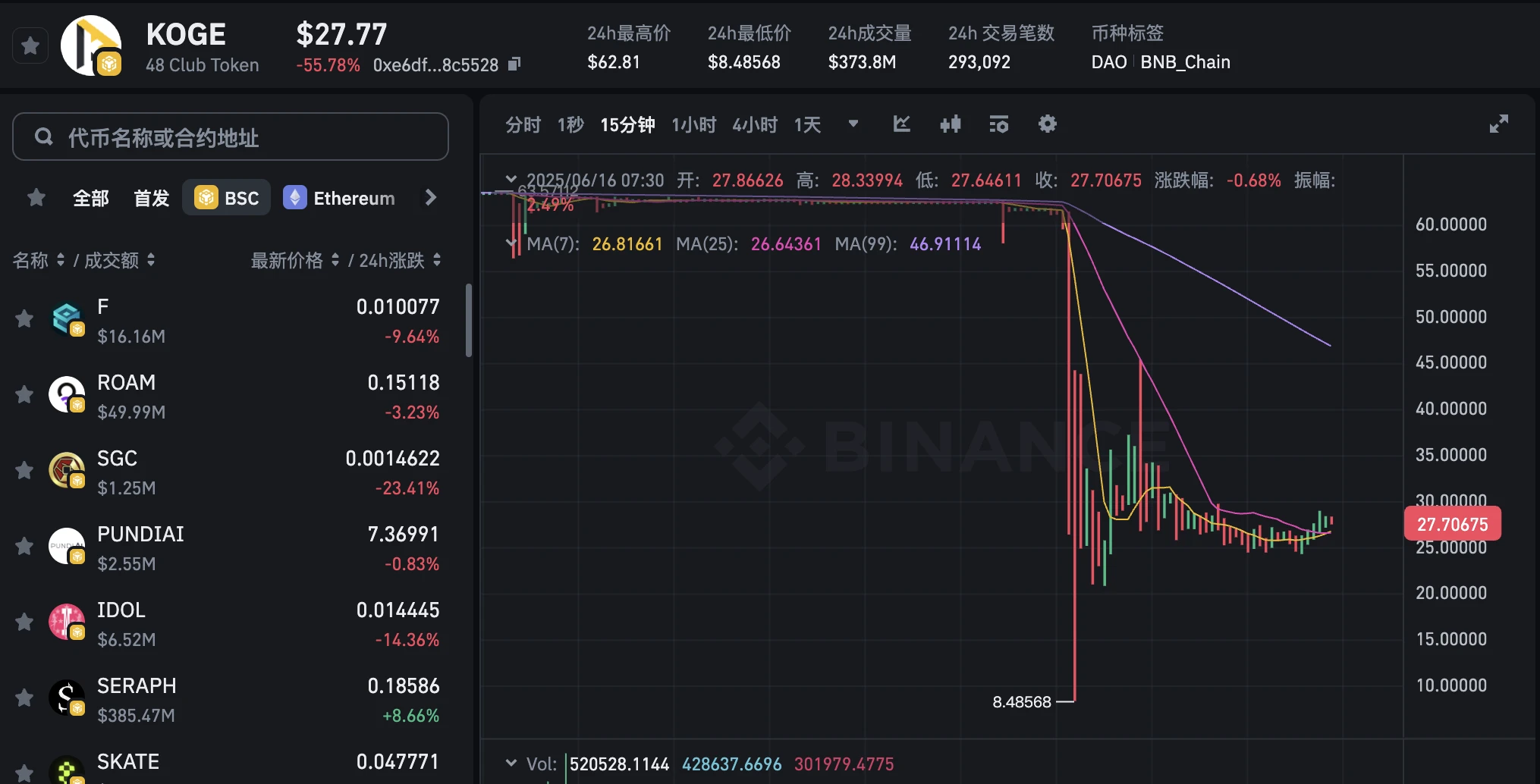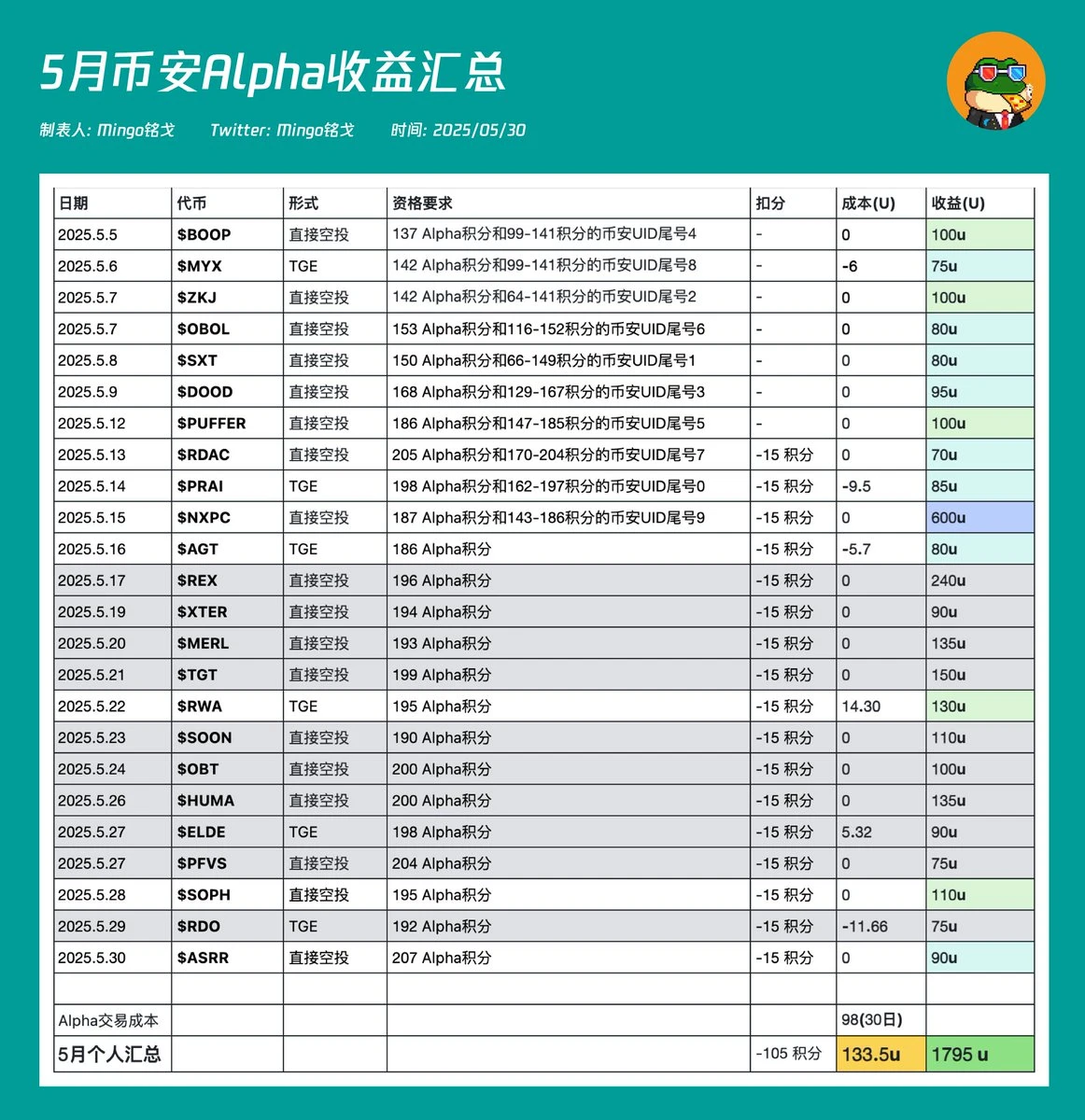KOGE and ZKJ closed overnight, and Binance Alpha was forced to grow
Original | Odaily Planeta Diario ( @OdailyChina )
Autor: Wenser ( @wenser 2010 )

Overnight, many Binance Alpha players found that the sky had fallen – the two major tokens KOGE and ZKJ, which have been used for Alpha points interaction, experienced a flash crash. As of the time of writing, the price of ZKJ was temporarily reported at US$0.32, with a 24-hour drop of 83.7% . Previously, its 24-hour highest price was US$1.98, and the lowest price once fell to US$0.25; the price of KOGE was temporarily reported at US$27.75, with a 24-hour drop of 55.78% . Previously, its 24-hour highest price was US$62.81, and the lowest price once fell to US$8.48.
The latest news is that Binance officially announced that it has noticed that ZKJ and KOGE have experienced significant price fluctuations recently. Preliminary investigations show that this is mainly due to large investors withdrawing on-chain liquidity and market chain liquidations. The Alpha points calculation rules will be adjusted from 00:00 (UTC) on June 17, 2025. At that time, the transaction volume between Alpha tokens will no longer be included in the points calculation.
The increasingly competitive Binance Alpha exam has finally reached a turning point due to the flash crash of the ZKJ/KOGE trading pair. Odaily Planet Daily will sort out the incident in this article and use it to explore the pros and cons of Binance Alphas mechanism and possible future directions.
A three-week Alpha Hunt: KOGE and ZKJ as the net, Alpha points as bait
On May 24, as the BTC market gradually rose, the markets enthusiasm for Binance Alphas score-brushing interactions also soared, and its trading volume once jumped to US$1.69 billion , of which ZKJs trading volume was US$1.05 billion, KOGEs trading volume was US$251 million, and B2s trading volume was US$205.9 million, ranking at the top.
Because ZKJ and KOGE tokens have low transaction wear and tear costs and sufficient liquidity, they can accommodate large transactions of more than tens of thousands of dollars to participate in Binance Alpha interaction. After being tested and proven effective by market traders, the two tokens have become the best choice for Alpha candidates. Among them, KOGEs single transaction wear and tear of nearly $10,000 can be controlled at around $0.5. Many users in the community responded that KOGE may be a model of killing two birds with one stone for large BSC ecosystem households.
Originally, this was a win-win game : Binance Alpha gained users and transaction fees; BSC node majors gained transaction fees; Binance Alpha users gained Alpha points; and project parties such as KOGE and ZKJ collected LP transaction fees and other returns.
But once the balance of interests begins to gradually tilt, the seemingly balanced situation will instantly collapse, and the hard-earned harvest stage will turn into a closing operation.
On June 14, ZKJ and KOGE tokens had their first downward test before the storm came – according to the monitoring of the on-chain analyst AI Aunt ZKJ and KOGE, which have always been stable, both fell by 3% between 21:20 and 22:05 that night, which was suspected to be caused by the withdrawal of liquidity and continuous selling at address 0x364 .
The address withdrew 1.29 million ZKJ and 8,667 KOGE bilateral liquidity from OKX at 21:49, and then:
At 21:21 and 22:05, a total of approximately $3.1 million of ZKJ was sold; at 21:20, approximately $550,000 of KOGE was sold.
ZKJs trading volume surged to $12.73 million at 21:21, triggering a continuous decline within 15 minutes, possibly due to a chain reaction caused by LP panic withdrawal;
A similar situation occurred at 22:05. KOGE was closely tied to ZKJ, so although the amount of selling was not large, it was also hit.
On June 15, ZKJ and KOGE finally closed the net . The three main addresses caused ZKJ and KOGE to collapse one after another through the dual pressure of large withdrawal of liquidity + continuous selling:
1. Address 0x1A2 withdrew 61,130 KOGE (about 3.76 million USD) and 273,017 ZKJ (about 532,000 USD) of bilateral liquidity in two batches at 20:28:21 and 20:33:15.
During 20: 28: 58 – 20: 36: 57, 45,470 KOGE were exchanged for ZKJ, worth 3.796 million USD. During this period, the transaction volume on the KOGE chain increased significantly.
During the period 20: 30: 57 – 20: 59: 49, 1.573 million ZKJ were sold in batches in exchange for USDT and BNB, with a value of 3.052 million US dollars and an average selling price of 1.94 US dollars.
At this time, both KOGE and ZKJ experienced a small step-down, but did not plummet.
2. Address 0x078 withdrew bilateral liquidity of 33,651 KOGE (about 2.07 million USD) and 709,203 ZKJ (about 1.38 million USD) at 20:30:33
During 20: 31: 10 – 20: 58: 18, 36,814 KOGE were exchanged for ZKJ, worth 2.26 million USD;
During the period 20: 35: 15 – 20: 37: 34, 1 million ZKJ were sold, with a value of 1.948 million US dollars and an average selling price of 1.948 US dollars.
The relay dumping of this address finally pushed the price of KOGE coin to plummet, which was reflected in the K-line as several consecutive large red negative lines.
3. Address 0x6aD received 772,759 ZKJ worth 1.5 million USD from address 0x078 (the second dumping address) at 20:41:55; 772,000 ZKJ were liquidated during 20:42:28 – 20:50:16. It can be seen that the third address is mainly used for coordination, further catalyzing the decline of ZKJ after the collapse of KOGE coin price, and completing the harvesting of LPs and holders of the two tokens.

ZKJ candlestick chart

KOGE candlestick chart
As for why the net closing operation started from ZKJ, according to the analysis of the on-chain analyst AI Aunt, it may be because ZKJ has a CEX contract, and the person behind the scenes can open a short position on the exchange and smash the market on the chain; secondly, from the perspective of liquidity, ZKJ has better liquidity, and it will cost more money to smash the market; in addition, the LP range of ZKJ and KOGE is extremely narrow. After a large number of smashes through this range, there is not enough funds to undertake the sell order, and there will be an inevitable flash crash. When LP sees the price of the currency falling, they will also flee in panic, and the vicious cycle will cause the price of the currency to collapse further; it is speculated that the decline in Alpha trading volume for several consecutive days may be the cause, and the exit of huge LPs is also a game of running fast.
Además, según the reminder of cripto KOL Dachengzi, the price of ZKJs BSC chain token is twice that of the ETH chain token. The Binance ZKJ contract is the ETH chain token. The BSC chain ZKJ token on Binance Alpha is actually a stand-alone coin, that is, the initial LP on BSC is provided by the teams own coins. The first wave of market crashes hit the BSC, and then someone followed suit and smashed the Bybit contract, and then the spot price of the ETH chain also collapsed.

BSC on-chain ZKJ token price on Binance Alpha
De acuerdo a Coinglass data , the total network liquidation volume in the past 24 hours was US$215 million, of which the long order liquidation amount was as high as US$157 million, and the ZKJ liquidation volume alone was as high as US$102 million. For the KOGE big players who used KOGE/ZKJ to complete liquidity exit, it was a bloody liquidity feast.

The largest single-coin liquidation occurred on Bybit
In general, the flash crash of ZKJ and KOGE was a premeditated hunting operation, and Binance Alpha points were bait that seemed delicious but was actually dangerous.
Traders trapped in the Binance Alpha siege: Points are like test scores, airdrops are both gifts and costs
After the ZKJ and KOGE flash crashes, the discussion about the Binance Alpha points system was heated. Many people only got the bitter fruit of asset loss of more than 80% in this incident, and thus had many complaints about the Binance Alpha mechanism. The official announcement of Binance at the first time also shows the seriousness of this incident.
Binance Alpha airdrop cannot offset ZKJ flash crash losses
As the on-chain analyst AI Aunt dicho , the total value of Binance Alphas airdrops for all projects so far is not as much as the market value lost by ZKJ. Its market value once crashed from 2 billion US dollars to 377 million US dollars, and about 81% of its market value evaporated in less than one day. This shows the high volatility and cruelty of the cryptocurrency industry. Many people invested thousands or even tens of thousands of dollars, and their assets shrunk by more than 80%.
De acuerdo a Estadísticas from X platform user Mingo Mingge, Binance Alphas monthly revenue in May was about 1,500 US dollars. For many people, after working hard for a month, this wave of direct closures will result in losses of thousands or even tens of thousands of US dollars, which is not worth the loss.

Binance Alpha May Revenue at a Glance
Binance Alpha Points Becomes a Numbers Game, Needs to Change its Thinking
After the incident, Binance also issued an announcement immediately, saying : We have noticed that ZKJ and KOGE have experienced significant price fluctuations recently. Preliminary investigations show that this is mainly due to large investors withdrawing on-chain liquidity and market chain liquidations. In order to maintain market fairness and stability and reduce systemic risks brought about by centralization, Binance will adjust the Alpha points calculation rules from 00:00 (UTC) on June 17, 2025. At that time, the transaction volume between Alpha tokens will no longer be included in the points calculation.
Later, Binance Alpha may need to change its purely digital game style. Specifically, the ideas for reference include:
1. Avoid the mechanism of trading volume being concentrated on a few tokens such as KOGE and ZKJ, and ensure that the interaction wear is relatively evenly controlled;
2. Increase the sources of Alpha points, not just limited to token transactions, such as community communication, Binance Square posts, and other talking that are more inclined towards InfoFi may also be considered as a way to interact with Alpha points;
3. Establish a monitoring mechanism to prevent the situation in which KOGE big holders manipulate a series of chains such as token issuance-liquidity pool creation-Alpha listing-Alpha points acquisition from happening again. Of course, this is highly idealistic and extremely difficult.
Summary: The liquidity feast is ultimately paid for by retail investors
In the end, the retail investors in the market were the ones who suffered the most. After all, Binance, as a platform, still reaped rewards such as transaction fees, while the big investors ZKJ and KOGE completed the liquidity harvest, and the retail investors in the market became the leeks that were harvested one after another.
But for the sickles, if the speed of such a scavenging harvest is too fast and the frequency is too high, who will continue to take over?
This article is sourced from the internet: KOGE and ZKJ closed overnight, and Binance Alpha was forced to grow







